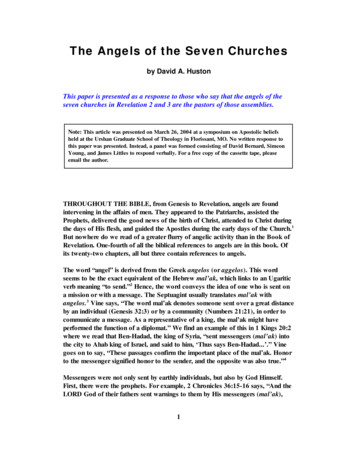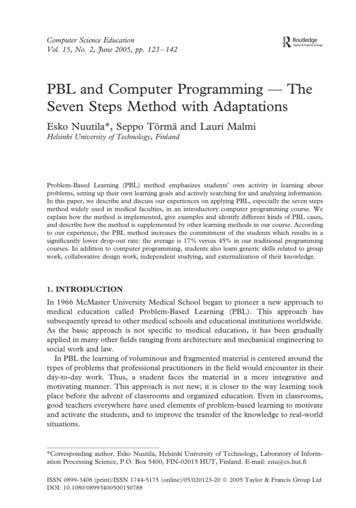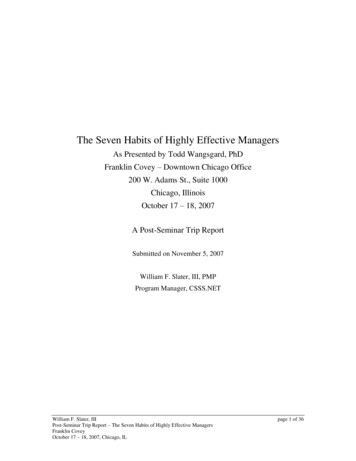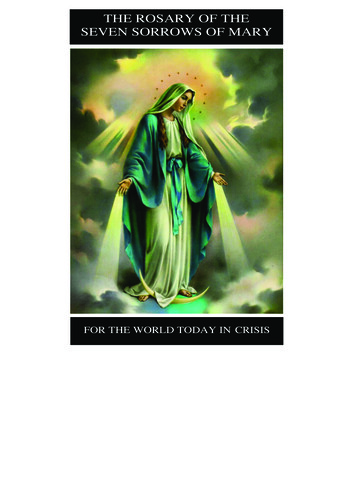
Transcription
The Angels of the Seven Churchesby David A. HustonThis paper is presented as a response to those who say that the angels of theseven churches in Revelation 2 and 3 are the pastors of those assemblies.Note: This article was presented on March 26, 2004 at a symposium on Apostolic beliefsheld at the Urshan Graduate School of Theology in Florissant, MO. No written response tothis paper was presented. Instead, a panel was formed consisting of David Bernard, SimeonYoung, and James Littles to respond verbally. For a free copy of the cassette tape, pleaseemail the author.THROUGHOUT THE BIBLE, from Genesis to Revelation, angels are foundintervening in the affairs of men. They appeared to the Patriarchs, assisted theProphets, delivered the good news of the birth of Christ, attended to Christ duringthe days of His flesh, and guided the Apostles during the early days of the Church.1But nowhere do we read of a greater flurry of angelic activity than in the Book ofRevelation. One-fourth of all the biblical references to angels are in this book. Ofits twenty-two chapters, all but three contain references to angels.The word “angel”is derived from the Greek angelos (or aggelos). This wordseems to be the exact equivalent of the Hebrew mal’ak, which links to an Ugaritic2verb meaning “to send.”Hence, the word conveys the idea of one who is sent ona mission or with a message. The Septuagint usually translates mal’ak withangelos.3 Vine says, “The word mal’ak denotes someone sent over a great distanceby an individual (Genesis 32:3) or by a community (Numbers 21:21), in order tocommunicate a message. As a representative of a king, the mal’ak might haveperformed the function of a diplomat.”We find an example of this in 1 Kings 20:2where we read that Ben-Hadad, the king of Syria, “sent messengers (mal’ak) intothe city to Ahab king of Israel, and said to him, ‘Thus says Ben-Hadad.’.”Vinegoes on to say, “These passages confirm the important place of the mal’ak. Honor4to the messenger signified honor to the sender, and the opposite was also true.”Messengers were not only sent by earthly individuals, but also by God Himself.First, there were the prophets. For example, 2 Chronicles 36:15-16 says, “And theLORD God of their fathers sent warnings to them by His messengers (mal’ak),1
rising up early and sending them, because He had compassion on His people andon His dwelling place. But they mocked the messengers (mal’ak) of God, despisedHis words, and scoffed at His prophets.”Haggai the prophet referred to himselfas “the messenger (mal’ak) of the Lord”(Haggai 1:13). Clearly both the wordmal’ak and its Greek equivalent angelos can, and in the Scriptures do, refer tohuman messengers sent by either God or some human agency for a specificpurpose. More often, however, these words refer to the spirit beings who serveGod as His special heavenly messengers. As with many biblical terms, thecontextual framework is the determining factor. In the classic sense, an angel is “aspiritual being, subordinate to God, who serves at God’s command and pleasure to5deliver his messages, help his people, and punish his enemies.”The QuestionDue to the use of a single word in Hebrew and Greek to signify both human anddivine messengers, in some biblical passages a certain amount of ambiguity arises.As with many ancient words, the meaning must be determined by the contextualframework. In the second and third chapters of Revelation, we read of Jesusdelivering important messages to seven churches located in Asia (present-dayTurkey). Each message begins with the words, “And to the angel (angelos) of the6church.”Whether these angels are human messengers or divine messengers canonly be determined by carefully examining the biblical context.In Apostolic circles, the angels of the seven churches are held by some to be thepastors of these churches. For example, Nathaniel J. Wilson writes: “When webegin to look into what is written, we find that, first of all, these letters werewritten to the ‘angel’of each of the churches. This is not speaking of an angelicspirit which brought the message to the churches, but rather to the individualpastors of those particular congregations. Even here, Christ continues to allow usto understand the importance of local church government and order by binding upthese congregations very closely with their pastors, and their pastors with them.Here, Christ shows that there is a ministry and an official God-equipped ‘gift’tothe Christian church of apostles, prophets, evangelists, and pastor-teachers, andthat Christ has a pastor for each local body and makes him its representative and7head.”In his commentary on the Book of Revelation, Paul Dugas writes: “The seven stars(of Revelation 1:16) in His right hand are the pastors of the seven churches. The8pastor stands between God and His church acting as a messenger.”On the surfaceat least, this would seem to establish a pastoral priesthood in the New Testament,an idea which conflicts with the doctrine of the priesthood of all believers. Writingsomewhat less dogmatically, Marvin D. Treece states, “It has been surmised that2
9the aggelos (messenger) is a reference to the pastor.”Apostolics are not the only ones who believe this interpretation. John F. Walvoord,former chancellor of Dallas Theological Seminary, writes, “These messengers wereprobably the pastors of these churches or prophets through who the message was10to be delivered to the congregation.”It is apparent that a certain degree ofequivocation exists in this area. The words “surmise”and “probably”are hardly thecurrency of sound doctrine.But are the angels of the seven churches the pastors of the local Asian assembliesor are they something else? Is there a way to resolve the seeming ambiguity andbring clarity to these verses? Perhaps these questions can best be answered bylooking at exactly what was going in the first three chapters of Revelation.The Origin of the MessageThe Book of Revelation begins with the words, “The Revelation of Jesus Christ,which God gave Him to show His servants.”(1:1). We discover in this openingstatement both the origin and the intended recipients of the book’s message. TheMighty God, manifested in the flesh as Jesus Christ, is communicating with “Hisservants.”As is common in the New Testament, God is depicted here in both Hisdeity and humanity. But as is always the case, the origin of the message is in thedeity, whom the man Jesus referred to as His Father. As John the Baptistexplained, “The Father loves the Son, and has given all things into His hand”(John3:35). And as Jesus Himself said during the days of His flesh, “The Son can donothing of Himself, but what He sees the Father do; for whatever He does, the Sonalso does in like manner. For the Father loves the Son, and shows Him all thingsthat He Himself does”(John 5:19-20). All divine things have their origin in theEternal Spirit we call God.This is not to suggest that God has two separate or independent personalities orcenters of consciousness. The Son is the Father manifested in the flesh (1 Timothy3:16; John 14:9). When the Bible states that God gave the Revelation to Jesus Christ,it is simply informing us that it did not originate in humanity but in the omniscientSpirit. We see the same concept depicted when Jesus said, “For as the Father has lifein Himself, so He has granted the Son to have life in Himself”(John 5:26). Lifeoriginates in God, but He imparts it to man through His human manifestation, HisSon, Jesus Christ. Understanding this distinction between the Father and the Son isvital to understanding the unity of the one God and how He relates to man in thispresent age. As Paul explained, “For there is one God and one Mediator betweenGod and men, the Man Christ Jesus.”(1 Timothy 2:5).3
Who are the Servants of God?We see then that the message of Revelation originated in the mind of the Spirit,who imparted it to His human manifestation “to show His servants.”Who then arethese servants of God? Since the Bible often defines its own terms, this questioncan best be answered by examining how the word “servants”is used throughoutthe Book of Revelation. For example, in Revelation 2:20, Jesus calls the people ofthe church in Thyatira “My servants.”In Revelation 7:3, the sealed members of thetwelve tribes are called “servants of our God.”In Revelation 11:18, those whoreceive rewards are called “Your servants the prophets and the saints.”InRevelation 19:2 those who are avenged by God are called “His servants.”And inRevelation 22:3, the Bible says that in the New Jerusalem “His servants shall serveHim.”These servants who dwell in the New Jerusalem are also described as “thosewho are written in the Lamb’s Book of Life”and those who have “His name.ontheir foreheads”(21:27; 22:4).These passages make clear that the servants of God referred to in the Book ofRevelation are God’s own people, the members of His body, the Church. In thefirst three chapters of Revelation, the servants of God are specifically the membersof the seven local assemblies in Asia. In a broader context, however, the term“servants of God”applies to all of God’s people in all ages. In this sense, the Bookof Revelation is for all believers today.As we have previously seen, some believe that the letters to the seven churcheswere addressed only to the individual leaders of each church. According to thisview, the term “His servants”refers only to local church pastors. This cannot be anaccurate interpretation, however, since both the letters and the entire propheticbook were directed toward the whole body of believers. In fact, each letterconcludes with these words: “He who has an ear, let him hear what the Spirit saysto the churches.”This shows definitively that the intended recipients of themessage of Revelation were not exclusively the seven assemblies in Asia or theirleaders, but all the churches.What was the delivery route?There is nothing unusual about God delivering messages to the seven churches,since He has communicated with His people ever since His first conversation withAdam in the Garden of Eden. What is unusual and intriguing about the messagesof Revelation is how they were delivered to these churches. The route thesemessages traveled took a unique turn which we see no other place in the Bible.To understand how God delivered the Revelation of Jesus Christ to His servants,4
we must continue reading Revelation 1:1, which says, “And He sent and signified itby His angel to His servant John.”As is common in the Bible, God sent Hisapocalyptic message by means of an angel (other examples of this can be found inMatthew 1:20; Luke 1:19, 26; Luke 2:9-10; Acts 5:19-20; Acts 8:26; Acts 10:3;Acts 27:23). What is unusual in this situation is that Jesus did not send the angeldirectly to the intended recipients but instead to John, the beloved apostle who wasimprisoned on “the island that is called Patmos for the word of God and for thetestimony of Jesus Christ”(1:9).According to history, the Romans used the small rocky island of Patmos as a penalcolony. It was here that John was sent and put to forced labor in the mines duringEmperor Domitian’s reign (A.D. 81-96).11 Perhaps this explains why Johndescribed himself to his audience as their “brother and companion in thetribulation”(1:9).To confirm to John that he was to pay close attention to this angel, Jesus made astriking personal appearance and instructed, “What you see, write in a book and sendit to the seven churches which are in Asia”(1:11). The angel was to show Johncertain future events, and John was to write what he saw in a book. The book thatJohn wrote was to then be sent to the seven Asian churches. Therefore, John’ssalutation reads: “John, to the seven churches which are in Asia: Grace to you andpeace from Him who is and who was and who is to come, and from the seven Spiritswho are before His throne”(1:4). Even though John wrote the book, he addressed itas though it were from Jesus (“Him who is and who was and who is to come”) andfrom “the seven Spirits who are before His throne.”Who are the seven Spirits?In Revelation 8:2 John reports seeing “the seven angels who stand before God.”In Revelation 4:5 John says that “seven lamps of fire were burning before thethrone, which are the seven Spirits of God.”Some have said that the seven Spiritsof God are actually the sevenfold Spirit of God; that is, seven attributes orexpressions of God’s one Spirit. But there is no basis for this interpretation fromthe context, the meaning of the Greek words, or the implications of the words. Anaccepted approach to interpreting the Bible is to set Scripture beside Scripture.When we do this, we immediately see that there are both seven spirits and sevenangels before God and His throne.The reference to “seven lamps of fire”is reminiscent of the seven lamps of theMenorah in the tabernacle of Moses (Exodus 25:37). This suggests that theseseven Spirits of God are agents of divine illumination. Yet throughout the Bible, itis the angels of God who serve as divine messengers, communicating God’s5
messages through dreams (Matthew 2:13), visions (Luke 1:19-22), and by directappearance and utterance (Matthew 28:2-5). These messengers are sometimescalled “angels”and sometimes “spirits.”For example, Acts 8:26 says, “Now anangel of the Lord spoke to Philip, saying, ‘Arise and go toward the south alongthe road which goes down from Jerusalem to Gaza.’”A few verses later we read,“Then the Spirit said to Philip, ‘Go near and overtake this chariot’”(8:29). Thetranslators have capitalized “Spirit”because they believe it is referring to the HolySpirit. But this verse is not speaking of God’s Spirit; it is referring to the angelwho was directing Philip’s evangelistic activities just a few verses before.Psalms 104:4 says that God “makes His angels spirits.”Hebrews 1:14 describesangels as “ministering spirits sent forth to minister for those who will inheritsalvation”(Hebrews 1:14). In Acts 23:9 a group of Pharisaic scribes warned, “If aspirit or an angel has spoken to him, let us not fight against God.”These menknew that to resist the message of an angelic spirit sent from God was equal tofighting against God Himself.In Revelation 2 and 3, the seven angels are each charged with imparting a portionof the Revelation of Jesus Christ to the churches in Asia. But John wrote that theletter was from both Jesus and “the seven Spirits who are before His throne.”Ipropose that he wrote his salutation this way because the seven spirits (lower case“s”) are the seven angels who were charged with delivering John’s book to theseven churches.Revelation 1:16 describes Jesus as having “in His right hand seven stars.”He laterexplains that “the seven stars are the angels of the seven churches”(1:20). TheBible frequently uses stars as a symbol of divine beings. For example, Stephencharged the Israelites with worshiping the host of heaven, which included “the starof your god Remphan”(Acts 7:42-43). The Book of Revelation describes a dragonwhose tail drew “a third of the stars of heaven and threw them to the earth,”anapparent reference to “the dragon and his angels”(Revelation 12:4, 7). At the timeof creation, we are told that “the morning stars sang together, and all the sons ofGod shouted for joy”(Job 38:7). Commenting on this verse, Matthew Henryidentifies that morning stars with “the blessed angels”and explains, “The angelsare called the sons of God because they bear much of his image, are with him in his12house above, and serve him as a son his father.”The term “right hand of God”is used throughout the Bible as a metaphor fordivine authority and power. In His appearance to John, Jesus is letting him knowthat these seven angels are operating by His power and under His authority. Theyare not to be ignored. This is not true of all angels, however. For example, Paulwarned the Galatian believers, “But even if we, or an angel from heaven, preachany other gospel to you than what we have preached to you, let him be accursed”6
(Galatians 1:8). Any angelic messenger that contradicts what God has alreadyestablished as truth is to be rejected as a false and evil spirit. As Paul cautioned,“For Satan himself transforms himself into an angel of light”(2 Corinthians 11:14).In Revelation 1:19 Jesus instructed John, “Write the things which you haveseen.”He then told him, “To the angel of the church of Ephesus write, ‘Thesethings says He who holds the seven stars in His right hand.’”(2:1). Paul Dugasexplains these instructions this way: “We specifically learn here that the message ofthe Lord is not given directly to the church laity, but is directed to the angel of the13church.”His use of the word “laity”betrays a fundamental flaw in Bro. Dugas’conception of the Church. It was the intrusion of Greek philosophy into Christianthought during the post-apostolic period that gave rise to the division between aso-called clergy and laity. Neither Jesus nor His apostles ever sought to establishsuch a division. In contrast, they taught that God speaks to local assembliesthrough a wide variety of spiritual gifts, not a single pastor/messenger.Revelation 2:1 is not a salutation to an angel or to a person in Ephesus. It is ratheran instruction from the Lord Jesus to John to write something down for the angelto deliver. The letter to Ephesus concludes with the words, “He who has an ear, lethim hear what the Spirit says to the churches.”This statement clearly shows thatthis letter was specifically for the assembly of Ephesus and in a general sense for allthe churches, which precludes the idea that the intended recipient was the angel.Are angels pastors?As we have seen, some Apostolics believe that the seven letters were only to theleaders or pastors of the seven assemblies. But the phrase “the angel of the church”cannot refer to a single leader/pastor of the Ephesian church. We know thisbecause Acts 20:17 says that Paul sent to Ephesus and called for “the elders of thechurch.”The church in Ephesus was led by a group of men called elders, not asingle leader/pastor.Pastoral leadership by teams of elders was the common arrangement in the earlyChristian assemblies. We see this in Acts 14:23 where Paul and Barnabas“appointed elders in every church”(Acts 14:23). We also see this practiceconfirmed in Paul’s instruction to Titus to “appoint elders in every city as Icommanded you”(Titus 1:5). Moreover, when giving instructions to those whoare sick, James writes, “Call for the elders of the church, and let them pray overhim”(James 5:14).The New Testament uses two words to designate those who lead a local assembly:“elder”(presbuteros) and “overseer”(episkopos). It never uses the word angel(angelos). Concerning the Greek word presbuteros, W. E. Vine writes: “In the7
Christian churches, those who, being raised up and qualified by the work of theHoly Spirit, were appointed to have the spiritual care of, and to exercise authorityover, the churches. To these the terms bishops, episkopoi, or overseers, is applied,the latter indicating the nature of their work, presbuteroi their maturity of spiritualexperience. The Divine arrangement seen throughout the N.T. was for a plurality14of these to be appointed in each church.”The connection between the terms “elder”and “bishop/overseer”can be seen intwo letters which were sent to the church in Philippi. When Paul wrote to thechurch during the first century, he addressed his letter, “To all the saints in ChristJesus who are in Philippi, with the bishops (episkopoi) and deacons (diakonoi)”(1:1). When Polycarp wrote to the same church around the middle of secondcentury, he referred to the leaders as the elders (presbuteroi) and the deacons(diakonoi).15 He did not use the term “bishops”or “overseers”(episkopoi) asfound in the salutation of Paul’s epistle. This does not indicate that the Philippianshad changed from bishop-leadership to elder-leadership, but that for all practic
held at the Urshan Graduate School of Theology in Florissant, MO. No written response to this paper was presented. Instead, a panel was formed consisting of David Bernard, Simeon Young, and James Littles to respond verbally. For a free copy of the cassette tape, please email the author. The











